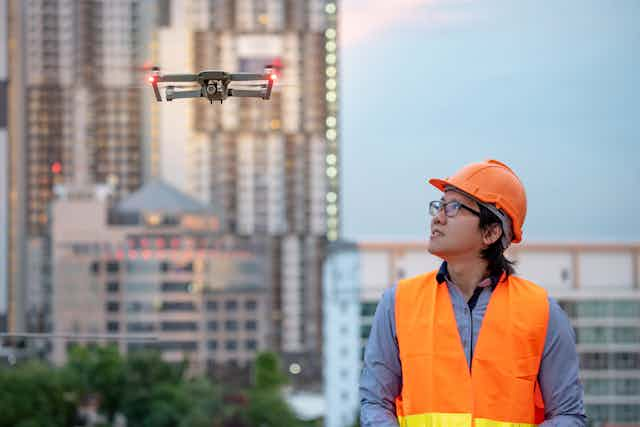Ready or not, autonomous robots are leaving laboratories to be tested in real-world contexts. With more and more people living in cities, these technologies offer ways to cope with ageing populations and poorly maintained infrastructures, while promoting safer transport, productive manufacturing and secure energy supplies.
Urban “living labs” are one way scientists are trying to understand how autonomous robots – or Robotics and Autonomous Systems (RAS), to give them their full title – will affect our everyday lives. Autonomous robots are interconnected, interactive, cognitive and physical tools, which can perceive their environments, reason about events, make or revise plans and control their own actions. These technologies are designed to draw on big data and connect with the Internet of Things, to make our lives easier by increasing accuracy and efficiency.
But the everyday dynamics of cities are complex, which makes them far less predictable than the usual test zones. City leaders recognise that real world experimentation can support innovation, as well as attracting international investment. As a result, cities around the world are competing to become urban test beds. But as a new white paper by researchers from Sheffield University’s Urban Institute sets out, there are some big challenges when it comes to promoting RAS technologies and ensuring meaningful trials in cities.
Last mile logistics
Logistics companies are under pressure to meet growing customer expectations for quick delivery, while battling against traffic congestion. Companies aim to fill this gap with last mile delivery robots. Alibaba recently announced that their bot, the G Plus, will go from being road-tested at their headquarters in Hangzhou, eastern China, to commercial operations by the end of 2018.
In this trial, consumers download an app, place a grocery order and pinpoint where they want their goods to be delivered. Purchased items are placed into the driverless bot, which can carry several packages of different sizes. The robot has a built-in navigation system that relies on LIDAR – a technology that bounces light off nearby surfaces to create a 360-degree 3D map of the world around it. It drives autonomously, at speeds of up to 9.3 miles per hour, to the delivery location, where the customer enters a PIN code to retrieve their shopping.
Similar tests are taking place in Milton Keynes, in the UK, and the US city of San Francisco. But these trials have not been without error – some delivery bots have experienced navigation issues, such as getting stuck or crashing into obstacles including people, not to mention resistance from citizens and activists interested in protecting public space and pedestrian safety.
Self-repairing cities
Buried under city streets are millions of kilometres of pipe and cable networks that provide essential water, drainage and energy services. There is mounting pressure on cities and utility companies to maintain these ageing invisible infrastructures, while dealing with the challenges of growing urban populations, ecological turbulence and citizens’ expectations.
Autonomous robots can detect defects in infrastructure – such as cracks in the asphalt – and identify and eliminate their triggers, whether it’s a leaking pipe or physical overloading. For example, The University of Leeds, together with local councils and industry partners, are running a project on self-repairing cities to test a range of autonomous robotic technologies.
There are drones that can perform remote maintenance of street lights; swarms of flying vehicles for autonomous inspection and repair of potholes on motorways; and hybrid robots designed to inspect, repair, meter and report the condition of utility pipes.
These robots can go where human access is impossible (inside pipes) or undesirable (at height in the streetscape) and work systematically over long periods (during overnight closures). Such technologies could greatly extend the life of vital city infrastructures, reduce maintenance expenditure and lead to massive savings.
But questions remain about how city areas and residential populations are selected to benefit from these upgrades. Authorities will need to ensure that it’s not just the affluent and well-connected areas of cities that benefit from RAS trials.
Robots that care
Humanoid robots are touted as the solution to urban policing, customer service and social care challenges. Pepper – a white humanoid robot standing just over a metre tall – has already taken up employment meeting, greeting and advising customers in over 140 SoftBank mobile phone shops in Japan, and Nestle is planning on installing Pepper in 1,000 sales outlets.
According to his developers, “Pepper has been designed to identify your emotions and to select the behaviour best suited to the situation”. Programmed to meet the individual care needs of patients, social robots such as Pepper are now being trialled as personal companions, to augment the role of human carers.
In 2017, care homes in Southend, Essex adopted the companion robot to interact with the elderly, raising fears that they could replace staff. Yet it’s forecast that the UK will need up to 700,000 more care workers by 2030.
Robots may help alleviate this pressure on care homes and hospitals, by allowing people to live independently in their own homes for longer, providing entertainment via memory games, and enabling better connection with loved ones through smart appliances. But while robots may be able to facilitate patient monitoring and help with physical tasks, arguably there can be no replacement for human emotional connection and sensitivities.
No longer simply fantasy or limited to niche applications, autonomous robots are slowly becoming a part of our everyday lives. While developers strive for RAS technologies to be neutral in design and to work seamlessly with the city and its citizens, there will always be challenges associated with this aspiration. That’s why urban “living labs” are crucial in demonstrating the opportunities and limits of autonomous robots, and ensuring that policies and standards are put in place to protect human rights, and guard against widening social inequalities.

